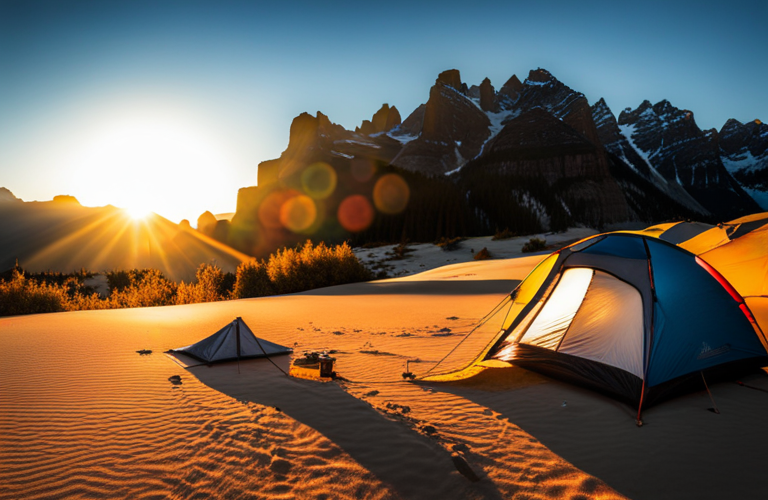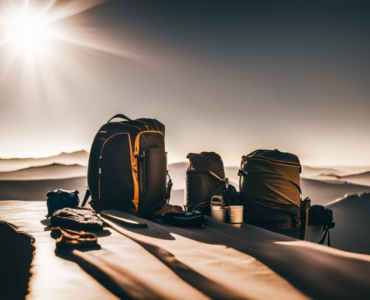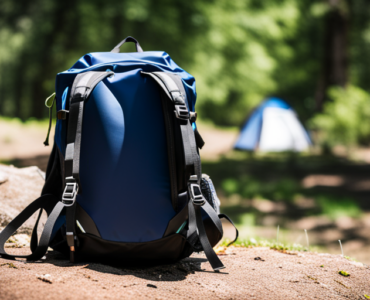Hey there! Are you an avid camper who loves spending nights under the starry sky? If yes, then you've come to the right place. Getting a good night's sleep while camping can sometimes be a challenge, especially when you don't have the right sleeping gear. But worry not, because in this how-to guide, I will share with you some amazing tips and tricks to optimize your camping experience by using the science of sleeping gear. So, grab a comfy seat, and let's dive in, shall we?
Table of Contents
Quick Tips
Tip 1: Choose the Right Sleeping Bag for You. Pick a sleeping bag that suits the weather conditions you will be camping in. Make sure it has a temperature rating that matches the lowest expected temperature to keep you warm and cozy all night long.
Tip 2: Use a Sleeping Pad for Comfort. Place a sleeping pad under your sleeping bag to add cushioning and insulation from the ground. This will help prevent discomfort and keep you warmer during chilly nights.
Tip 3: Dress Appropriately for Bedtime. Wear clean, dry clothes to sleep in. Layer up if it's colder or remove layers if it's warmer. By dressing appropriately, you'll ensure a comfortable and temperature-regulated sleep.
Tip 4: Utilize Extra Insulation. Carry an extra blanket or wear a hat and socks to provide additional warmth. Remember, it's better to have extra insulation and not need it, than to need it and not have it. Stay snug and ensure a cozy night's sleep.
Choose a sleeping bag with the right temperature rating for your camping conditions
When you're planning a camping trip, one of the most important things to consider is the temperature rating of your sleeping bag. Choosing a sleeping bag with the right temperature rating ensures that you'll stay warm and comfortable throughout the night. To find the perfect sleeping bag for your camping conditions, follow these simple steps.
First, determine the typical weather conditions of your camping destination. Will it be hot or cold? Will there be a chance of rain or snow? Once you have an idea of the conditions you'll be facing, you can look for a sleeping bag with the appropriate temperature rating. For colder temperatures, you'll want a sleeping bag with a lower rating, such as 0 degrees Fahrenheit (-18 degrees Celsius). For milder climates, a sleeping bag with a higher rating, such as 30 degrees Fahrenheit (-1 degree Celsius), may be sufficient.
Next, consider your personal preferences and tolerance to cold. Some people naturally feel colder or warmer than others, so it's important to take that into account. If you tend to get cold easily, it's a good idea to choose a sleeping bag with a slightly lower temperature rating than what the conditions require. On the other hand, if you tend to feel hot during the night, you may want to opt for a sleeping bag with a slightly higher temperature rating to prevent overheating.
By following these simple steps, you can choose a sleeping bag with the right temperature rating for your camping conditions. This will ensure that you have a comfortable and restful night's sleep, no matter how cold or hot it may be outside. Remember to always check the temperature rating before purchasing a sleeping bag and consider your personal preferences to guarantee your camping adventures are filled with warmth and coziness.
Dr. Matthew Walker: The Science & Practice of Perfecting Your Sleep | Huberman Lab Podcast #31
Consider the weight and packability of your sleeping bag for easy transportation
When you're planning a camping trip, one of the most important things to consider is your sleeping bag. Not only does it need to keep you warm and comfortable, but it also needs to be easy to transport. That's why it's crucial to consider the weight and packability of your sleeping bag. You don't want to be lugging around a heavy and bulky bag on your back, especially if you have to hike to your campsite. Look for sleeping bags that are made from lightweight materials, such as down or synthetic fibers. These bags are not only lighter, but they also compress easily, allowing you to pack them down into a smaller size.
Another factor to consider when choosing a sleeping bag is its temperature rating. Make sure to pick a bag that is suitable for the climate and conditions you'll be camping in. If you're going camping in the summer, you'll want a bag that is designed for warmer temperatures. On the other hand, if you're camping in colder weather, you'll need a bag that offers more insulation. Keep in mind that a higher temperature rating means more insulation, which can add weight and reduce packability. Finding the right balance between warmth and weight is key.
As a final suggestion, make sure the sleeping bag you choose is the right size and shape. Look for bags that are long enough to comfortably fit your height, but not too big that you'll be swimming in extra space. Consider the shape as well – mummy-shaped bags are more form-fitting and efficient at trapping body heat, while rectangular bags provide more room to move around. However, rectangular bags are generally bulkier and heavier. By taking into account the weight, packability, temperature rating, size, and shape of your sleeping bag, you can ensure easy transportation and a good night's sleep during your camping adventure.
Use a sleeping pad or insulated mattress to provide insulation and cushioning
When you're camping or sleeping outdoors, it's essential to use a sleeping pad or insulated mattress for insulation and cushioning. Let me tell you how to choose the right one for your needs. First, consider the type of camping you'll be doing. If you're backpacking and need to keep things lightweight, a self-inflating sleeping pad is a great option. Simply unroll it, open the valve, and let it inflate on its own. If you're car camping or have more space to carry gear, an inflatable mattress may provide more comfort with added thickness and softness.
Next, consider the insulation provided by the sleeping pad or mattress. Insulation is crucial for keeping you warm during chilly nights. Look for sleeping pads that have an R-value, which measures their insulating performance. The higher the R-value, the better the insulation. If you're camping in colder climates, aim for a pad with a higher R-value to ensure you stay warm throughout the night.
You should also pay attention to the type of cushioning provided by the sleeping pad or mattress. This is important for both your comfort and overall support. Look for pads with enough thickness to cushion your body against the hard ground. Additionally, some pads have contoured or ridged designs that provide extra support for your back and joints. Take your personal preferences into account when choosing the right level of cushioning; some people prefer a softer pad, while others may like a firmer surface. Ultimately, the right sleeping pad or insulated mattress will provide you with the insulation and cushioning you need for a restful night's sleep in the great outdoors.
Opt for a tent with good ventilation and waterproof capabilities
The most important aspect of camping is a reliable tent. That's why it's crucial to choose a tent that has good ventilation and water resistance. You want a tent that will keep you dry during rainstorms and won't leave you feeling suffocated on a hot summer night. Look for one with mesh panels and windows to allow for airflow and prevent condensation. Additionally, make sure the rainfly is made of waterproof material to keep you protected from the elements.
To start, look for a tent with a rainfly that extends all the way to the ground. This will provide maximum coverage and prevent rainwater from seeping into your shelter. Also, check if the tent has a bathtub-style floor, which means the floor is higher on the sides to prevent water from entering underneath. This way, you can sleep soundly knowing you won't wake up to a soggy sleeping bag.
Another important aspect to consider is the tent's ventilation system. Look for a tent with mesh panels and windows that can be opened and closed as needed. This will allow fresh air to circulate inside and prevent condensation buildup, especially during hot and humid nights. Good ventilation is not only crucial for your comfort but also for reducing the risk of mildew or mold growth inside the tent.
The most important things to consider when choosing a tent are the ventilation and waterproof capabilities. These features will ensure that you stay dry and comfortable throughout your camping trip. Look for a tent with a rainfly that extends to the ground and a bathtub-style floor to keep water out. Additionally, seek out tents with mesh panels and windows that can be opened and closed as needed to allow for proper airflow. With the right tent, you can fully enjoy your outdoor adventure without worrying about rainy weather or stuffy nights.
Conclusion
By choosing a sleeping bag with the right temperature rating, you can ensure comfort and avoid extreme temperatures while camping. Learning the science behind sleeping gear will help you make the right choice for your camping trip. Considering the weight and packability of your sleeping bag allows for easy transportation and convenience while hiking. Additionally, using a sleeping pad or insulated mattress not only provides insulation but also offers cushioning and support for a restful night's sleep. By paying attention to these factors, you can significantly improve your camping experience, ultimately enhancing your overall enjoyment and well-being in the great outdoors. So, take the time to invest in high-quality sleeping gear, and watch as your camping adventures become even more rejuvenating and memorable.
FAQ
FAQ: The Science Of Sleeping Gear – How To Optimize Your Camping Experience
Q1: Why is it important to have proper sleeping gear while camping?
A1: Proper sleeping gear significantly impacts the quality of your sleep and overall camping experience. It provides insulation, comfort, and protection against the elements. Choosing suitable gear can prevent discomfort, promote better rest, and ensure you wake up refreshed and ready to enjoy your outdoor activities.
Q2: What are the essential components of camping sleeping gear?
A2: The essential components include a sleeping bag, sleeping pad or mattress, and a pillow. Additionally, depending on the weather, you might need a tent, sleeping bag liner, or a camping hammock. These items collectively provide insulation, support, and comfort while you sleep outdoors.
Q3: How do I choose the right sleeping bag?
A3: When choosing a sleeping bag, consider factors such as temperature rating, insulation type, weight, size, and shape. Temperature rating indicates the lowest temperature at which the bag will keep you warm. Insulation type can be down or synthetic, each with its pros and cons. Weight and size should align with your camping preferences. The shape (mummy, rectangular, or semi-rectangular) affects warmth and freedom of movement.
Q4: What is the difference between down and synthetic insulation?
A4: Down insulation is lighter, more compressible, and has better longevity. It offers exceptional warmth-to-weight ratio, making it ideal for colder climates. Synthetic insulation is generally more affordable, retains insulating properties even when wet, and dries faster. It is a great alternative in damp or humid environments.
Q5: How do I choose the right sleeping pad or mattress?
A5: When selecting a sleeping pad or mattress, prioritize factors such as comfort, insulation, portability, and durability. Consider the pad's R-value, which indicates its ability to retain heat. A higher R-value is needed for colder climates. Sleeping pads can be self-inflating, foam, or air to suit your preferences, and mattresses often provide additional comfort through thicker padding.
Q6: Is a pillow necessary for camping?
A6: While some campers can do without a pillow, having one can significantly improve your sleep quality. Pillows designed for camping are lightweight and packable. They provide neck support, enhance comfort, and promote better spinal alignment.
Q7: Should I use a sleeping bag liner?
A7: Sleeping bag liners are optional but can be beneficial in various situations. They add an extra layer of warmth, protect your sleeping bag from dirt and sweat, and are easier to clean than a sleeping bag. Liners can also be used alone in warmer climates or as a standalone sleeping option if you prefer not to use a bag.
Q8: How do I maintain and care for my sleeping gear?
A8: To maximize the lifespan of your sleeping gear, follow the manufacturer's instructions. Keep your gear clean and dry, avoiding prolonged exposure to moisture and direct sunlight. Regularly air out your sleeping bag and pad. Additionally, store the gear in a dry and well-ventilated area when not in use.
Q9: Can I use regular bedding items for camping?
A9: While it is possible to use regular bedding items for camping, they may not provide adequate insulation or be suitable for outdoor use. Camping-specific sleeping gear is designed to be lightweight, moisture-resistant, and durable, ensuring comfort and protection in various weather conditions.
Q10: Are there any specific considerations for camping sleeping gear for different seasons?
A10: Yes, the weather conditions and seasons should guide your choice of camping sleeping gear. For winter camping, choose gear with higher insulation and temperature ratings and consider additional accessories like tent insulation or a four-season tent. In warmer months, prioritize breathability, ventilation, and lightweight options for optimum comfort.










Add comment